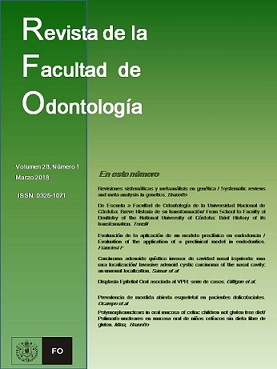Polymorphonuclears in oral mucosa of celiac children not gluten free diet
Keywords:
Celiac Disease, Leukocytes, Stomatitis, AphthousAbstract
Our work group first described the presence of Polymorphonuclears (PMNs) in the oral mucosa smears of children patients with CD and not comply a gluten-free diet. The objective of this work was to associate the PMN in oral mucosa smears of celiac children and factors as recurrent aphthous stomatitis (RAS) or other typical signs and symptoms. To established two groups: a) celiac children (CD) (n=27); b) non celiac children (NCD) (n=24) were not affected by gastrointestinal pathology or other diseases related to CD and negative for IgA AGA, IgG AGA, total IgA, and IgA EMA. Both groups included, female/male, 4-12 years old with similar sociodemographic, cultural, and odonto-medical features. It recorder the irritable behavior, RAS and pick-up smears of non-keratinized zones of oral cavity. The association between PMN and RAS in celiac children was evaluated by logistic model and bivariate relations by Fisher test. For all test the statistical significance was set p<0.05. RAS were observed in a significantly higher percentage (p=0.0007) in CD children (55.6%) compared to NCD (8.3%), while PMNs were only observed in CD children (44.4%; p=0.0002). Also, 70.4% of children with CD exhibited anxiety state in comparison to 12.5% of NCD children (p=0.0001). A strongly significant association was observed between the presence of RAS and its lesions and PMNs in smears of CD. Our results showed an association between PMNs and RAS in CD children, probably due to anxiety and/or stress states in children having CD. It could be said that in CD patients not complying with a gluten free diet, PMNs and other specific markers could be used as markers of a presumptive diagnosis; also, in patients with a confirmed diagnosis, they could signal the fulfillment of a diet together with other signs and symptoms.Downloads
Published
2018-03-30
Issue
Section
RESEARCH
License
Aquellos autores/as que tengan publicaciones con esta revista, aceptan los términos siguientes:
- Los autores/as conservarán sus derechos de autor y garantizarán a la revista el derecho de primera publicación de su obra, el cuál estará simultáneamente sujeto a la Licencia de reconocimiento de Creative Commons que permite a terceros:
- Compartir — copiar y redistribuir el material en cualquier medio o formato
- La licenciante no puede revocar estas libertades en tanto usted siga los términos de la licencia
- Los autores/as podrán adoptar otros acuerdos de licencia no exclusiva de distribución de la versión de la obra publicada (p. ej.: depositarla en un archivo telemático institucional o publicarla en un volumen monográfico) siempre que se indique la publicación inicial en esta revista.
- Se permite y recomienda a los autores/as difundir su obra a través de Internet (p. ej.: en archivos telemáticos institucionales o en su página web) después del su publicación en la revista, lo cual puede producir intercambios interesantes y aumentar las citas de la obra publicada. (Véase El efecto del acceso abierto).

